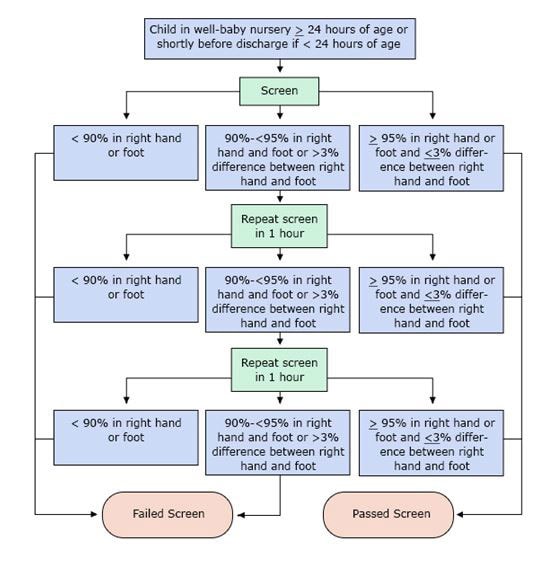What Common Finding Can the Nurse Identify in Most Children With Symptomatic Cardiac Malformations?

Newborn screening for disquisitional congenital heart defects (Critical CHDs) can place newborns with these conditions before signs or symptoms are evident and before the newborns are discharged from the birth hospital.
Critical CHD Screening Methods
Current published recommendations focus on screening newborns in the well-baby nursery and in intermediate intendance nurseries or other units in which discharge from the hospital is mutual during a newborn'south first week of life. Timing the screening around the fourth dimension of the newborn hearing screening tin can help ameliorate efficiency. A pulse oximeter is used to measure the pct of hemoglobin in the claret that is saturated with oxygen.
The following algorithm has been developed to show the steps in screening (Kemper et al., 2011)

Delight Annotation: Percentages refer to oxygen saturation every bit measured by pulse oximeter.
Pulse oximetry screening should not supersede taking a complete family health history and pregnancy history or completing a physical examination, which sometimes can detect a critical CHD before the development of low levels of oxygen (hypoxemia) in the blood.
Screening with pulse oximetry tin can place a number of types of disquisitional CHDs, the most common of which are shown in the box beneath. While not the main targets of screening, many conditions other than disquisitional CHD may present with hypoxemia and thus likewise be detected via pulse oximetry.
- Hemoglobinopathy
- Hypothermia
- Infection, including sepsis
- Lung affliction (congenital or acquired)
- Non-critical congenital heart defect
- Persistent pulmonary hypertension
- Other hypoxic conditions not otherwise specified
Failed Screens
A screen is considered failed if:
- Any oxygen saturation mensurate is <ninety% (in the initial screen or in repeat screens),
- Oxygen saturation is <95% in the right hand and pes on 3 measures, each separated by ane hour, or
- A >3% absolute difference exists in oxygen saturation between the correct manus and foot on 3 measures, each separated by one hour.
Any baby who fails the screen should have an evaluation for causes of hypoxemia. In well-nigh cases this will include an echocardiogram, simply if a reversible cause of hypoxemia is identified and appropriately treated, an echocardiogram may not exist necessary. The infant'southward pediatrician should be notified immediately and the babe might need to exist seen by a cardiologist.
Passed Screens
Any screening with an oxygen saturation mensurate that is ≥95% in the right hand or pes with a ≤3% absolute divergence between the right hand or human foot is considered a passed screen and screening would end. Pulse oximetry screening does not detect all critical CHDs, then it is possible for a baby with a passing screening result to all the same have a critical CHD or other CHD.
Means to Reduce False Positive Screens
- Screen the newborn while he or she is alert.
- Screen the newborn when he or she is at least 24 hours old.
Other Tools or Resource
American Academy of Pediatrics: Disquisitional Built Heart Defect (CCHD) Screening Resource for Primary Intendance Providersexternal icon This online resource was developed past doctors for doctors, to assist primary care providers navigate the implementation process and provide effective, long-term medical homes for babies with critical CHDs.
American University of Pediatrics: Endorsement of Health and Man Services Recommendation for Pulse Oximetry Screening for Critical Built Heart Disease [Read article ]
Children's National Medical Center's Congenital Heart Disease Screening Programme has created videosexternal icon near disquisitional CHD screening for parents and healthcare professionals.
Congenital Middle Public Wellness Consortiumexternal icon (CHPHC) The CHPHC is a group of organizations uniting resource and efforts in public health activities to prevent congenital heart defects and improve outcomes for affected children and adults. Their website provides resources for families and providers on heart defects and screening.
Kemper AR, Mahle WT, Martin GR, Cooley WC, Kumar P, Morrow WR, Kelm G, Pearson GD, Glidewell J, Grosse SD, Lloyd-Puryear M, Howell RR. Strategies for implementing screening for critical congenital middle affliction. Pediatrics. 2011; 128:e1-8. [Read article pdf icon [406 KB / 11 pages] ]
Knapp AA, Metterville DR, Kemper AR, Prosser L, Perrin JM. Evidence review: Critical built cyanotic heart disease, Terminal Draft, September 3, 2010. Prepared for the Maternal and Child Health Bureau, Health Resource and Services Administration. [Read article pdf icon [524 KB / 46 pages] ]
Mahle WT, Newburger JW, Matherne GP, Smith FC, Hoke TR, Koppel R, Gidding SS, Beekman RH, tertiary, Grosse, SD. Part of pulse oximetry in examining newborns for congenital center disease: A scientific argument from the AHA and AAP. Pediatrics. 2009;124:823-36. [Read articleexternal icon]
NewSTEPSexternal icon This webpage on disquisitional congenital heart defects provides a central location for resources related to these conditions, including webinars, legislative updates, and news.
NIH/NLM Newborn Screening Coding and Terminology Guideexternal icon This guide provides the data standards for electronic reporting of critical built center defects.
Thangaratinam South, Brown One thousand, Zamora J, Khan KS, Ewer AK. Pulse oximetry screening for critical built heart defects in asymptomatic newborn babies: a systematic review and meta-assay. Lancet. 2012; 379:2459-64. [Read commodityexternal icon]
Disclaimer: Linking to a not-federal site does not institute an endorsement of the sponsors by CDC, HHS, or whatsoever of its employees; nor does it found an endorsement of the information and products presented on the site.
Source: https://www.cdc.gov/ncbddd/heartdefects/hcp.html
0 Response to "What Common Finding Can the Nurse Identify in Most Children With Symptomatic Cardiac Malformations?"
Post a Comment